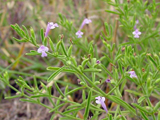Native Plants

Q. Who is Mr. Smarty Plants?
A: There are those who suspect Wildflower Center volunteers are the culpable and capable culprits. Yet, others think staff members play some, albeit small, role. You can torture us with your plant questions, but we will never reveal the Green Guru's secret identity.
Did you know you can access the Native Plant Information Network with your web-enabled smartphone?
Ask Mr. Smarty Plants is a free service provided by the staff and volunteers at the Lady Bird Johnson Wildflower Center.

rate this answer
Friday - November 07, 2014
From: Angleton, TX
Region: Southwest
Topic: Plant Identification, Herbs/Forbs
Title: Identity of blue sage-like plant blooming in September in Lubbock TX
Answered by: Nan Hampton
QUESTION:
This has bothered me for years. It looks like a miniature version of Salvia azure. About a foot talk with multiple stems. Flowering in September. Grows on the hillsides overlooking Buddy Holly Lake in Lubbock. Grows with blackfoot daisy, blue gramma and feathered dalea. Looks biennial to perennial. It's not a skullcap. Thank you.ANSWER:
Since you say it isn't Salvia azurea (Pitcher sage) (USDA Plants Database distribution map shows it occurring in adjacent Lamb County although not in Lubbock County) or Scutellaria resinosa (Resin-dot skullcap) ( USDA Plants Database distribution map shows it occurring in Lubbock County), Mr. Smarty Plants is left with only a few choices that are native and in the Family Lamiaceae (mint family) with flowers that would resemble Salvia azurea. (You will note that I interpreted "blue" rather broadly, including "purple" and "violet" in my search terms as well). They are:
- Hedeoma drummondii (Drummond's false pennyroyal) USDA Plants Database distribution map shows it occurring in Lubbock County. Here are more photos and information from Southwest Colorado Wildflowers.
- Salvia reflexa (Lanceleaf sage) USDA Plants Database distribution map shows it occurring in Lubbock County.
There are three native species of Monarda that occur in Lubbock County, although I don't think they really fit your description. They are
Monarda pectinata (Pony beebalm)
Monarda citriodora (Lemon beebalm)
Monarda clinopodioides (Basil beebalm)
There is one other possibility in the mint family, Lamium amplexicaule (Henbit), an introduced non-native species, that is shown occurring in Lubbock County on the USDA Plants Database distribution map. Here are more photos of henbit from Identify That Plant.
Here are a few possibilities from the Family Scrophulariaceae (Figwort Family) that has flowers that are similar in structure to the mint family flowers.
Nuttallanthus texanus (Texas toad-flax) The USDA Plants Database distribution map shows it occurring in Lubbock County. it normally blooms February through May.
Penstemon buckleyi (Buckley's penstemon) blooms in April-May. The USDA Plants Database distribution map shows it occurring in Lubbock County.
Penstemon fendleri (Fendler's penstemon) blooms April through July. The USDA Plants Database distribution map shows it occurring in Lubbock County.
If none of the above is the plant you saw in bloom in September and you have a photograph or photographs, please visit our Plant Identification page to find links to several plant identification forums that will accept photos of plants for identification. You might also consider contacting someone in the South Plains Lubbock Chapter of the Native Plant Society of Texas to see if they can help you identify the plant.
From the Image Gallery
More Plant Identification Questions
Diamonds and Rubies plant (Lychnis coronaria)
May 02, 2007 - I recently purchased a plant from the Huntsville, AL Botanical Gardens at their annual plant sale. The name on the plant tag is "Rubies and Diamonds". No one at the Botanical Garden knew the scien...
view the full question and answer
Fragrant night blooming plant
June 09, 2009 - My Grandmother use to have a night fragrant night blooming plant that she referred to as "baby Jesus being born" when it bloomed.
Are you familiar with anything of this nature?
view the full question and answer
Information about plant called Josephs tears, possibly Jobs tears (Coix lacryma-jobi)
October 08, 2007 - I recently received a plant and was told it was a succulent called Joseph's Tears. According to the individual who gave it to me, during the month of September it develops a little growth at the tip...
view the full question and answer
Two-leafed trilliums
June 17, 2012 - Turns out our 2 leafed plant IS a trillium..I saw that another person from our town also asked about trilliums..we are happy to have them, but it is confusing when the third upper leaf is absent or ve...
view the full question and answer
What is the orange vine that is covering the wildflowers from Llano, TX?
April 10, 2012 - What is the invasive orange vine that is covering the wildflowers on Texas highways?
view the full question and answer
| Support the Wildflower Center by Donating Online or Becoming a Member today. |

